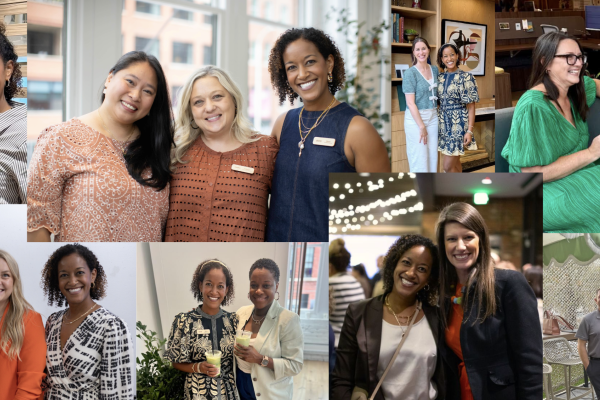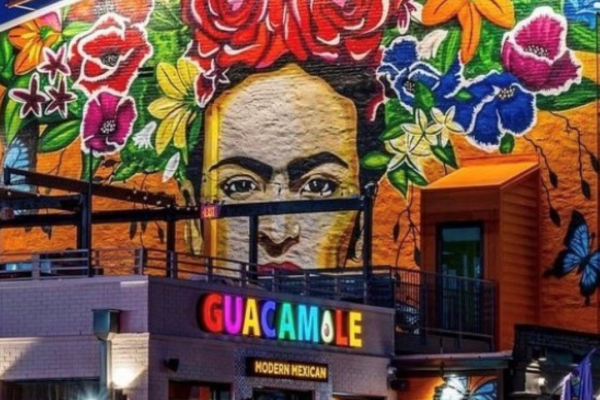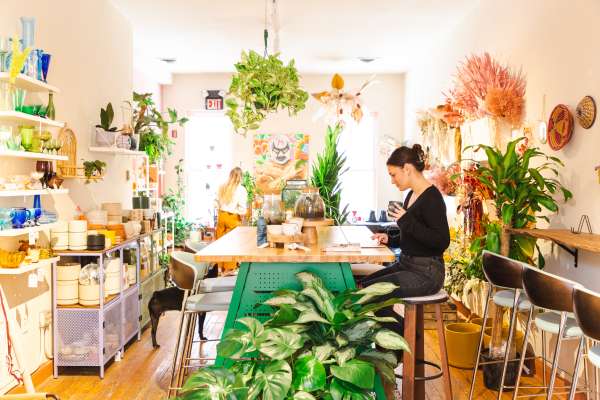A pathway to design | An interview with Cheryl S. Durst
For over 4 years the team at IIDA has been working on developing a program to help expose underrepresented communities to the power of design to change our lives. The lack of representation within the industry has been top of mind for some time, but a program to help change this became real as a series of dramatic global events changed our lives.
If the potential of Design Your World resembles anything close to the interest and curiosity of the first class of teens in Chicago, the future of design is bright and filled with possibilities. But the challenges are real and the work ahead will require the entire industry to participate in some way.
This past Spring we spent time with Cheryl S. Durst and the amazing Design Your Word team at IIDA headquarters in an unusually quiet downtown Chicago. The challenges of remote working, masks, and keeping a safe distance never deterred the team from sharing passionately about the intent, hopes, and dreams for this exciting program.
A Vision for Design Your World
What was the vision for Design Your World?
“The vision for IIDA with Design Your World is first built around helping young people understand what design is and understand that it is a viable career. Secondly, it's built around equity and inclusion and diversity. I am a firm believer in you have to see it to be it. So through Design Your World, we're exposing a community of teenagers who may not have been exposed to design in a way that many of us were. And we want to make design real for them.
Essentially, Design Your World is a pathway program, because the goal is ultimately to bring more underrepresented communities into design as a career. But you must expose them to design first, and one of the things we know about design is people feel it and they see it before they understand it. And that is another goal of Design Your World, is to have an intellectual explanation of what design is and its impact on a single individual and its impact on a community.”
Activism and Design
What influenced the IIDA to launch Design Your World now?
“After the recent events of racial injustice and social unrest, we were all influenced by the movement and activism. Even before this our team and the international board of directors were talking about bigger and better ways we could explain design. The demographics of the design industry have always been dismal as far as underrepresented communities and minorities are concerned. And so we looked for a way to put our beliefs into action, to put our activism into action. For me personally, as a black woman, it was incredibly important to talk about this exposure of design to underrepresented communities.
And so the convergence in this moment where so many people were becoming activists about what was going on in the world, we've always been activists about design. And we knew that in order to, again, talk about design and explain design, we had to pull people in. We had to draw them in. And that's how Design Your World happened. It started out as a passion project and the ability to make it real through the support of incredible sponsors. It's just so gratifying to see it happen.”
Hope + power
What is the hope for this program?
“We hope that this program will address some of the issues that these kids have around feeling powerless. And we know that design is a career that allows agency. It allows wherewithal. And one of the most important things that this program can do is show these kids that they have power over their condition, over their neighborhoods, over their communities, over stereotypes, over prejudice. Getting their heads, their hearts and their hands wrapped around design will give them a superpower.
I think when they finish the program, I'm hoping that they will come through it understanding that design has a place for them. That they will be exposed through the instructors, through guest speakers, in seeing themselves reflected in successful designers that they see a place for themselves in design as a career, that they see how design impacts their lives, possibly as future designers, that they will be able to impact the lives of others. I used the word agency earlier, and I really want these kids to understand that they aren't victims of a system. They're not victims of a neighborhood. They're not victims of a community."
I'd like them to see that design is a way to advance, to elevate, to articulate some dreams and some thoughts through design. If one kid comes through this program and design touches their soul, we will have been successful.”
Cheryl's story
When did you realize your passion for art, design, and space?
“I grew up in Toledo, Ohio, and I remember at the age of six going to the Toledo Museum of Art, a phenomenal museum. Looking around, not at the art on the walls, but at the space. And it was visceral. It evoked emotion. I was fascinated by the vastness of the space and I was fascinated watching how people moved through that space. And I didn't have a name for that then.
I was at the museum with my parents, and my mother was a scientist, a specialist in infectious diseases. She was a microbiologist. My father was a principal of an elementary school. I remember asking my parents, "How does this work? How do people know how to get from point A to point B?" And my parents knew that was evincing for me a fascination with wayfinding. And then I asked my parents, "Who works in museums?" Because I knew I wanted to be in that space. And so my parents explained to me that curators and there's a museum director and there are people who are docents and walk people through museums. And I said, "Oh, that's what I want to do. I want to be a curator." So, this was the '60s, the late '60s. And both of my parents, the wonderful, educated people that they were, said to me, "Oh, Black people don't do that."
"And it was the feeling of being in that space, I was gobsmacked by the space. And you hear so many people now talk about how they were told by their parents, "You can do anything." That often is not the experience for people of color. That's often not the experience for Black people. We're often told, "Do your best at whatever you do. But you may not be able to do everything." And I now understand retrospectively, my parents didn't want me to have my heartbroken. They didn't want me to enter what they saw as a field where I would be the only one.
And in so many minority communities or immigrant communities, or first-generation going to college communities, you are tracked into a more traditional, read as respected career, like being a teacher, being a nurse, being a doctor, being a lawyer. And that stayed with me for a very long time. I ended up pursuing my education and I went to school in Boston, in journalism and economics, because I also wanted to be a writer and I wanted to take complicated, arcane things and translate them into really easily digestible material. But I minored in art history because I kept that love of art. I ended up coming out of Boston and there was a recession going on in the '80s, and I was a substitute teacher for many years in Washington, D.C., and became a docent at the Smithsonian."
"I went from being a substitute teacher to working at the Washington Design Center for Knoll, and my role was in creating training programs for salespeople. And then I put together a curriculum for designers when legislation was coming forward in the district. And then I was hired by IIDA to be their first director of education. So there's always been this through-line of education, articulating purpose and strategy. And so even though I didn't become that curator, I still feel like I'm curating experiences in what I do now."
And how that ties back for me to the kids who will be coming through Design Your World, some of them may not ever become designers, but the skill that they will amass in learning about design may take them in so many other places. And so I think for all of us when we look retrospectively at where we've come from, that we're able to put some pieces together, and I want to equip those kids with experiences that allow them to put together this longitudinal track that gets them someplace amazing that they never even imagined. That's my short story.”
A message to members and industry leaders
What would you tell your members about this program and why this is so critical for the future of the industry?
“I would tell IIDA members that this program is critical, crucial for the industry, because we all know and firmly believe that design is for everybody, yet design isn't done yet by everybody. And so our goal for this program is to amass everybody. We have to gather, we have to convene, we have to educate, but above and beyond that, we've got to ignite some passion. We have to be a catalyst for education, and design is probably one of the least understood professions. Right? Um, and so what we're doing, um, with this program, with Design Your World, would be planting those seeds of understanding, and that's critical.
If there were 600 IIDA designers in this room, there might be 600 different stories of how they all came to design. But it began with exposure. Something ignited that passion. Something happened deep inside for them, and we want to do that same thing for these kids who'll be a part of Design Your World.”
What would you tell the industry leaders of other organizations trying to make a difference?
“So, if I had industry folks in this room, I would tell them that the immediate payoff for being participatory in a program like Design Your World, is a really good feeling, because you are doing something wonderful, for a single child, for a community. There's a longer-term payoff, and that's the introduction to this industry. So I would also tell them to be patient because the immediate results that we're going to see will probably be from the kids, some interest, some delight, some excitement, that in and of itself is fantastic, but the longer-term payoff, in supporting a program like this is you're literally changing the face of this industry and giving it some much-needed change.
You're broadening the perspective of design and so a program like Design Your World is not only going to benefit the kids that are participating, it's going to benefit this industry by changing the entire perspective on what we think design is and how design is practiced.”
The industry needs to be disrupted
What we're talking about is an empathetic way to bring everybody to the table, right? Who else benefits from this?
“A diverse table will provide some much-needed perspective to what I think is still very much an insulated, sometimes very precious industry. I think we need to acknowledge our privilege as a part of this industry. We're in a bubble, and it's safe and it's shiny and it's a small world, and we know one another. And we're comfortable with one another, and that bothers me. Because it is fairly homogeneous. The industry needs to be disrupted, and there are a lot of ways to disrupt an industry, but an infusion of people who haven't typically been a part of that industry is yet another form of disruption and much-needed disruption.
We need to be made uncomfortable. We need to be pulled out of our Eurocentric point of view, because again, I go back to that assertion that in theory, design is for everybody, but it hasn't always been purveyed, offered, and been available to everybody. And this begins the change that starts creating a wider path for design, and so I think that the sponsors who are participating in this and the folks that were brought in to teach and to educate and the guest speakers will be learning as much or should be as open to learning as much as the kids that are participating.
It can't be one-sided. That's paternalistic. That's like someone labeling themselves an ally because they feel sympathetic, and allyship is not sympathy, so that's not what we're looking for here. We're looking for an all-in, eyes wide open, feet on the ground posture. I'm going to do something for this industry and take a stand for diversity in this industry by opening up the doors, even kicking open the doors in the industry.”
How we talk about design
How can this program help us to break down walls?
“Well, you know, there's a preciousness that's associated with design, particularly interior design. It is viewed by a lot of people as a luxury, as opposed to a necessity. And I think one of the things we'll be talking about through Design Your World, I'm gonna use a word that's not a word, but the necessariness of design. That design is life-affirming, that design brings value, that design brings satisfaction, that design is an expression of love, and I think particularly in commercial design, we've moved away from talking about the beauty of design in lieu of talking about the business of design.
We've left it cold. We've left it sterile. Perhaps we've done that because we didn't want to be aligned with decoration. And so we built this very beautiful, sterile, clinical wall around commercial design, but it makes it even more precious when you build a wall around it, and I think what we want and need this program to do is tear down those walls, and it will free us as much to talk about the beauty and the passion of design, because that comes out whenever a designer is explaining design to someone else, to a client or to their mother. They do indeed talk about beauty and passion."
"Design is about what happens on the receiving end, and I think we need to maybe rethink how design is branded, again, interior design, how we talk about it, and not be ashamed of the passion and not be ashamed of the beauty. That's what attracts human beings to design. It calls to the deepest, most ancient part of our brain, and I think to evince some of that, I think will be healing. I think it will be helpful, and I think it will reinvigorate the designers to maybe rediscover some of their passion around design, and let's not be fearful of being described as something else.
The interesting thing around this is the kids who are going to be participating in the program, all their lives have been labeled as something else or someone else or you can't have this or you can't have that. But the beauty of design is it tells us that this is for you.”
Hear more from Cheryl S. Durst and Ciera C.Payton on the Imagine a Place podcast:






























